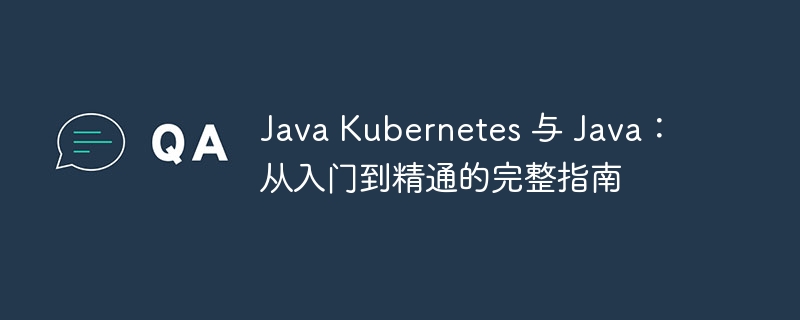Home >Java >javaTutorial >Java Kubernetes vs. Java: A Complete Guide from Beginner to Mastery
Java Kubernetes vs. Java: A Complete Guide from Beginner to Mastery
- WBOYWBOYWBOYWBOYWBOYWBOYWBOYWBOYWBOYWBOYWBOYWBOYWBforward
- 2024-02-20 10:39:16540browse

kubernetes Introduction
"Java Kubernetes and Java: A Complete Guide from Beginner to Master" recommended by php editor Zimo is a guide that comprehensively introduces Java and Kubernetes. This book explains the relevant knowledge of Java and Kubernetes in detail from entry to mastery, helping readers quickly master the skills in these two fields. Whether you are a beginner or an experienced developer, you can benefit from it. This guide will provide you with a comprehensive and systematic learning path, allowing you to easily master the practical skills of Java and Kubernetes.
Why use Kubernetes
Kubernetes offers a range of advantages that make it ideal for managing containerized applications:
- Resource Scheduling: Kubernetes can automatically discover and schedule containers, and allocate resources according to the needs of the application to ensure the stable operation of the application.
- Service Discovery: Kubernetes provides a unified entry point for containers so that applications can easily discover and connect to other services.
- Load balancing: Kubernetes can automatically adjust the number of copies of containers based on application traffic to ensure the stability and availability of services.
- Storage orchestration: Kubernetes supports a variety of storage systems and provides persistent storage volumes for applications to ensure application data security and recoverability.
- Network management: Kubernetes provides a powerful set of network management functions, including network policies, service mesh, etc., helping developers easily build safe and reliable network architecture.
Java Kubernetes Getting Started
1. Install Kubernetes
The installation process for Kubernetes varies depending on the operating system. For linux users, you can use kubeadm or kubespray and other tools to install. For windows users, you can use Docker Desktop and other tools to install.
2. Create Kubernetes Cluster
After creating a Kubernetes cluster, you can use the kubectl command line tool to manage resources in the cluster. kubectl is the command line client for Kubernetes, used to create, modify, and delete resources in the cluster.
3. Deploying Java applications
To deploy a Java application to a Kubernetes cluster, you can use the following steps:
- Package Java applications as container images.
- Push the container image to the image warehouse.
- Create resources such as Deployment or Service in the Kubernetes cluster and specify the container image to be deployed.
- Use the kubectl command line tool to monitor and manage the running status of the application.
4. Manage Kubernetes cluster
Kubernetes clusters require regular maintenance and management to ensure the stability and security of the cluster. You can use the kubectl command line tool to perform the following operations:
- Check the usage of cluster resources.
- Upgrade Kubernetes version.
- Back up and restore cluster data.
- Manage the security and access control of the cluster.
5. Java Kubernetes Advanced
Once you have mastered the basics of Kubernetes, you can further learn the following:
- Use Helm to manage Kubernetes applications.
- Use Istio to build a service mesh.
- Use prometheus and Grafana Monitor Kubernetes cluster.
- Build serverless applications using Knative.
Frequently Asked Questions
1. What is the difference between Kubernetes and Docker?
Kubernetes is a container orchestration system used to manage the deployment and operation of containerized applications. Docker is a container engine used to create and manage container images.
2. What languages does Kubernetes support?
Kubernetes is a language-agnostic system that supports any language that can run in a container, including Java, python, c , etc.
3. Does Kubernetes support Windows?
Yes, Kubernetes supports Windows. However, Windows supports relatively few Kubernetes versions.
Summarize
Kubernetes is a powerful container orchestration system that provides Java developers with rich features to help them easily build and manage distributed applications. This article provides an introductory guide to Kubernetes to help Java developers learn Kubernetes from scratch and apply it to the deployment and management of applications.
The above is the detailed content of Java Kubernetes vs. Java: A Complete Guide from Beginner to Mastery. For more information, please follow other related articles on the PHP Chinese website!
Related articles
See more- How to implement microservices in golang
- 10 beautiful and practical Bootstrap background management system templates (come and download now)
- How to deploy applications using Docker containerization in FastAPI
- How to build a containerized big data analysis platform on Linux?
- Build containerized microservice applications using Docker and Spring Boot

